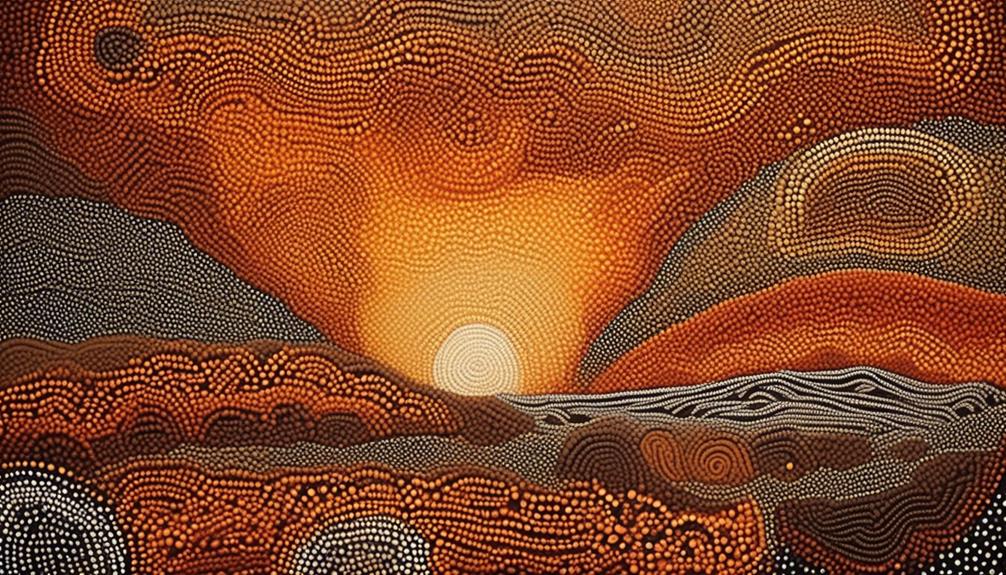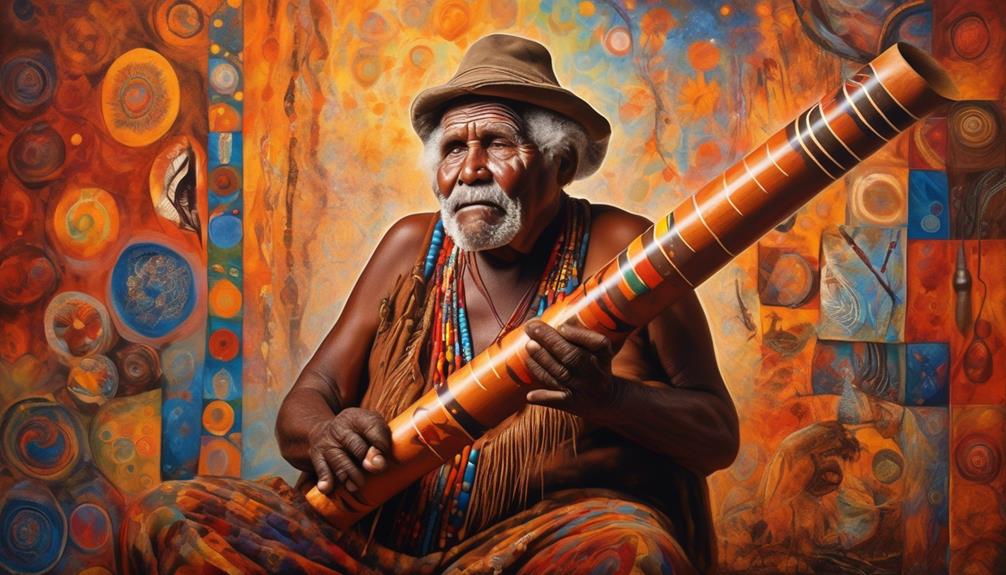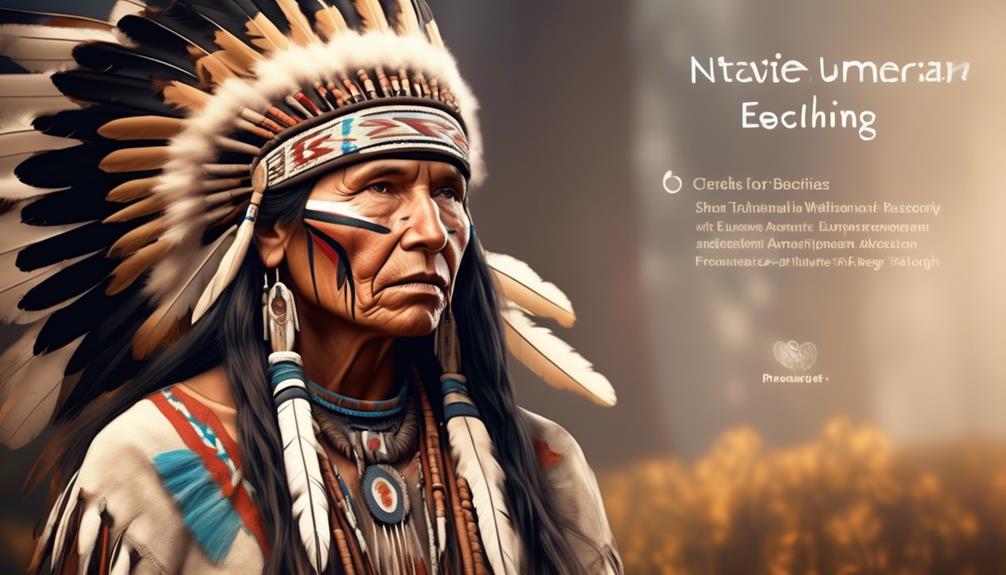Do you think that dot painting is just about putting dots on a canvas? Think again. The deep history and cultural significance of Aboriginal Dot Painting often go unnoticed.
As we explore the origins and symbolism of this sacred art form, you'll be surprised to uncover the layers of meaning and techniques that have been passed down through generations.
But it doesn't stop there – the contemporary adaptations and impact of Aboriginal Dot Painting in modern art will leave you with a newfound appreciation for this traditional practice.
Key Takeaways
- Aboriginal Dot Painting is an ancient cultural practice that is deeply rooted in traditions, spiritual beliefs, and the Dreamtime.
- The use of dots, lines, and circles in the paintings carries profound meaning and is used to convey stories, ancestral journeys, and the location of resources.
- Traditional techniques and materials, such as natural pigments sourced from the land, are used to create the paintings, reflecting the artists' respect for the land and ancestors.
- Aboriginal Dot Painting has evolved to incorporate modern materials and techniques, while still maintaining its cultural significance and fostering a sense of identity and belonging for Indigenous communities.
Origins of Aboriginal Dot Painting
The origins of Aboriginal Dot Painting can be traced back to ancient cultural practices, where intricate patterns and symbols were used to convey stories, traditions, and spiritual beliefs. This form of artistic expression holds immense cultural significance for Indigenous Australians, serving as a visual language that encapsulates their deep connection to the land, ancestral knowledge, and the Dreamtime. The use of dots in painting represents a significant artistic innovation, as it allowed artists to encode sacred knowledge and maintain cultural traditions while adhering to strict protocols regarding the depiction of sacred stories and symbols.
These paintings aren't merely decorative; they're a repository of cultural knowledge, serving as a way to pass down important information from one generation to the next. The intricate use of dots and the stories they convey are integral to the preservation and continuation of Indigenous traditions. The artistic innovation of using dots in this manner reflects a profound understanding of the natural world, spiritual beliefs, and the interconnectedness of all things, making Aboriginal Dot Painting a unique and powerful form of cultural expression.
Symbolism and Meaning in Dot Painting
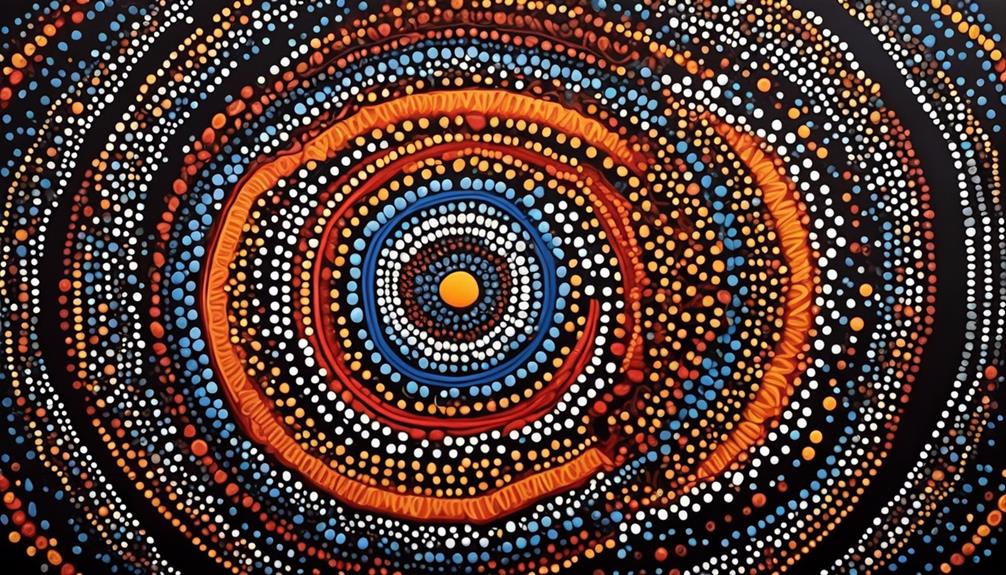
Exploring the intricate patterns and symbols in Aboriginal Dot Painting reveals a rich tapestry of cultural significance and spiritual depth. The use of symbols in dot painting serves as a form of symbolic representation, where each dot, line, or circle carries profound meaning and cultural storytelling. These symbols aren't merely decorative; they convey a complex web of stories, traditions, and connections to the land.
For instance, concentric circles may represent sacred sites or waterholes, while wavy lines might depict travel paths or ancestral journeys. The colors used also hold symbolic significance, with ochre representing the earth and white symbolizing the sky or clouds.
Furthermore, the placement of dots within the artwork can convey specific information, such as the location of resources or the presence of significant landmarks. The careful arrangement of these dots not only creates visually stunning patterns but also serves as a means of passing down cultural knowledge from one generation to another.
In essence, Aboriginal Dot Painting is a visual language that encapsulates the deep-rooted traditions and spiritual beliefs of the Indigenous Australian peoples.
Traditional Techniques and Materials
Using traditional natural pigments and a meticulous application process, Aboriginal Dot Painting exemplifies the profound connection between the artists and their cultural heritage. Natural pigments, such as ochre, charcoal, and clay, hold deep cultural significance as they're sourced from the land, carrying spiritual meanings and connections to ancestral traditions.
The artistic process involves gathering these pigments from specific sites, preparing them through grinding and mixing with natural binders like water or animal fat, and applying them using traditional techniques passed down through generations. This process reflects the artists' respect for the land and their ancestors, making each artwork a profound expression of cultural identity and continuity.
The historical significance of using natural pigments and traditional techniques in Aboriginal Dot Painting lies in the preservation of indigenous knowledge and the maintenance of cultural practices. These materials and methods have been integral to the art form for thousands of years, representing a timeless link to the past while also serving as a form of resistance against colonial attempts to erase indigenous culture.
Evolution and Contemporary Adaptations
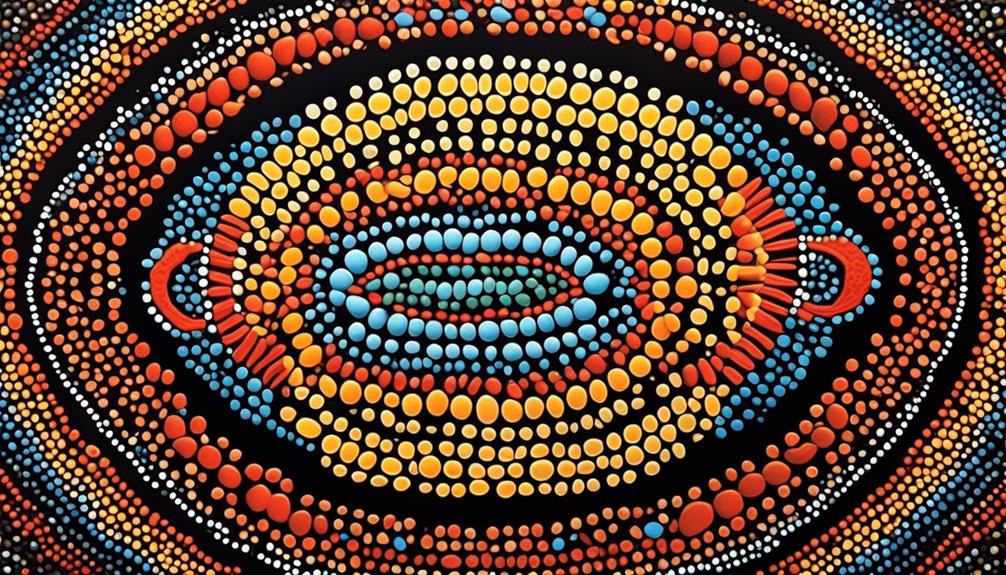
Adapting to contemporary influences, Aboriginal Dot Painting has evolved to incorporate modern materials and explore new artistic expressions while maintaining its cultural significance and connection to ancestral traditions. This evolution reflects the resilience and adaptability of Aboriginal art in responding to the changing world while preserving its roots.
The evolution of Aboriginal Dot Painting exemplifies the dynamic nature of Indigenous art, showcasing how tradition and innovation can intersect to create new forms of cultural expression.
The use of acrylic paints and canvas has become more prevalent, allowing artists to experiment with a wider color palette and larger-scale works, while still adhering to the fundamental dotting techniques.
The continued cultural significance of Aboriginal Dot Painting lies in its role as a visual storytelling medium, conveying the Dreamtime narratives and ancestral connections. This art form serves as a bridge between the past and the present, fostering a sense of identity and belonging for Indigenous communities while also inviting broader audiences to engage with their heritage.
This evolution not only demonstrates the adaptability of Aboriginal Dot Painting but also highlights its enduring cultural significance in contemporary contexts.
Impact and Recognition in Modern Art
The impact and recognition of Aboriginal Dot Painting in modern art reflects the enduring resonance of Indigenous cultural narratives and the growing appreciation for its unique visual language. The recognition of Aboriginal Dot Painting as a significant art form has been steadily increasing, with its cultural significance being acknowledged by art institutions and collectors worldwide. This recognition isn't merely a trend, but rather a testament to the enduring influence and global appeal of this art form.
The influence of Aboriginal Dot Painting can be seen in the work of contemporary artists who've been inspired by its visual language and storytelling traditions. This influence hasn't only permeated the art world but has also contributed to a greater understanding and appreciation of Indigenous art and culture on a global scale.
In modern art, the impact of Aboriginal Dot Painting lies in its ability to challenge and expand the boundaries of traditional Western art forms, offering a new perspective and enriching the artistic landscape with its unique aesthetic and cultural depth. The growing recognition of Aboriginal Dot Painting serves as a bridge between ancient narratives and contemporary artistic expressions, fostering a deeper understanding of Indigenous cultures and their artistic contributions to the world.
Frequently Asked Questions
How Do Aboriginal Artists Decide on the Colors to Use in Their Dot Paintings?
We choose colors based on their symbolism and our artistic inspiration. We carefully consider the meaning behind each color and how it fits into the overall message or theme of our work.
Our choices are influenced by cultural significance and the emotions we want to evoke in the viewer. This thoughtful approach allows us to create art that conveys deep and meaningful messages through the use of color.
Are There Specific Rules or Guidelines for Creating Dot Paintings, or Is There Creative Freedom for the Artist?
When it comes to dot paintings, creative freedom is key. Artists often draw from traditional techniques, but there's also room for modern interpretations.
The cultural significance of the artwork allows for a range of styles and approaches, giving artists the flexibility to express their unique vision.
This blend of tradition and innovation has contributed to the ongoing evolution of dot painting as a vibrant and dynamic art form.
Do Aboriginal Dot Paintings Always Have a Specific Story or Meaning Behind Them, or Are They Sometimes Purely Abstract?
Abstract interpretations of Aboriginal dot paintings aren't always purely abstract. While some artworks may have specific stories or meanings behind them, others allow artistic freedom in expression. This balance between cultural significance and artistic freedom is evident in traditional techniques.
The complexities of these paintings invite exploration, revealing layers of interpretation and cultural depth. Thus, the interplay between narrative and abstraction offers a rich tapestry of meaning within Aboriginal dot paintings.
What Role Do Women Play in the Creation of Aboriginal Dot Paintings, and Are There Any Specific Traditions or Customs Related to Their Involvement?
Women's roles in the creation of art have evolved over time and vary across cultures. Their involvement often holds deep cultural significance, tied to traditional customs and color symbolism.
In many societies, women play a central role in preserving artistic traditions and passing down cultural knowledge through their artistic expressions. This involvement reflects the interconnectedness of art and daily life, highlighting the importance of women in shaping and maintaining cultural identity through their creative contributions.
How Do Aboriginal Communities View the Commercialization and Mass Production of Dot Paintings, and What Efforts Are Being Made to Protect the Integrity of This Art Form?
We believe that the commercialization of Aboriginal art presents a complex challenge. Many communities view it as a threat to the integrity of their cultural heritage. Efforts to protect this art form involve advocating for stricter regulations to prevent cultural appropriation and mass production.
Aboriginal art preservation is crucial for maintaining the authenticity and significance of these traditions. It's essential to recognize and respect the cultural and spiritual meanings behind each dot painting.
Conclusion
In conclusion, Aboriginal dot painting is like a vibrant tapestry, weaving together stories, traditions, and cultural identity. Through its intricate patterns and rich symbolism, it serves as a powerful expression of Aboriginal culture and spirituality.
As it continues to evolve and gain recognition in modern art, it stands as a testament to the resilience and creativity of Indigenous peoples. Aboriginal dot painting isn't just a form of art, but a living connection to the past and a bridge to the future.
Mary is a passionate writer who brings creativity and a fresh perspective to our team. Her words have the power to captivate and inspire, making her an essential contributor to our content. Mary’s commitment to storytelling and dedication to promoting Indigenous culture ensures that her work touches the hearts of our readers. We’re fortunate to have her as part of our team.
